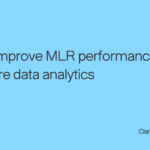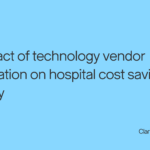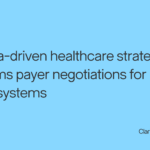This is part three of our three-part series about how health plan leaders can leverage healthcare claims data to reduce costs, strategically grow their networks, provide best-in-class member services, and enhance outcomes for their members. In healthcare, the shift towards personalized, value-based care is no longer a preference but a necessity. The rise of increasingly personalized services — driven by ever-evolving technology — has reshaped how businesses of all kinds interact with consumers. Collecting and leveraging vast amounts of data makes these individualized interactions possible. And comprehensive claims data in healthcare is transforming how health plans manage and deliver care. Tailoring healthcare experiences to members’ changing needs, preferences, and specific health profiles is arguably one of the most impactful ways anyone can use big data. Predictive analytics enables health plans to optimize operational efficiencies, mitigate risks, and reduce costs. Predictive analytics can be defined as identifying patterns found in historical and real-time data to anticipate outcomes and trends. In healthcare, predictive analytics is particularly powerful because better outcomes can be life changing. When health plans optimize their processes and improve their services, it’s a win-win for the plan and its members. Payers can adopt early intervention strategies by using healthcare claims data to predict which patients are at risk of developing serious health issues. This proactive approach improves patients’ overall health and reduces the need for costly treatments like emergency room visits and lengthy hospitalizations. Early detection and management of chronic conditions significantly cut healthcare costs. Preventative care reduces the expense of acute care episodes, ultimately boosting a payer’s bottom line. Healthcare claims data analytics makes it possible to increase profits by avoiding the necessity for a claim in the first place. For example, predictive analytics can help identify members at risk for Type II diabetes, which can often be prevented with dietary changes and medications. That’s a much more cost-efficient approach than treating a medical emergency like severe hypoglycemia. With predictive analytics, health plans can create personalized health programs that cater specifically to members’ needs. This customization boosts member satisfaction and fosters loyalty, reducing churn rates, and increasing a patient’s likelihood of adhering to their treatment plans. By analyzing claims data, healthcare organizations can obtain detailed insights into treatment outcomes and patient satisfaction, which are essential for maintaining high standards and fostering a culture of continuous improvement. Enhanced metrics provide payers with a means to monitor and ensure that care standards are consistently met across the board. This continuous monitoring helps identify areas where improvements are necessary, allowing for swift interventions. Plus, providers can use these metrics to analyze performance feedback, helping them improve their practices based on objective data. Health plans can use claims data-enabled insights to shape policies that further high-quality, patient-centric care. By understanding patterns and trends within the data, policymakers can create targeted initiatives aimed at specific health issues. Analytics-driven policies can also promote the efficient allocation of resources, maximizing the payers’ positive impact on their members. High-quality care is a significant differentiator in the healthcare market. Payers who highlight and promote providers with excellent care scores stand out in an increasingly competitive landscape. Leading with a quality-first approach attracts new customers looking for reliable healthcare and bolsters the plan’s reputation for quality among existing members. Finally, predictive analytics enables more effective member engagement. Leveraging healthcare claims data can help healthcare organizations develop targeted communications with patients. Timely, relevant information about their health encourages members’ active participation in their health journeys. Predictive analytics boosts payer efficiency by encouraging members to stay with their healthcare plan and reducing overall healthcare costs. Effective engagement strategies ensure that members feel valued and understood, which are crucial to fostering loyalty and reducing turnover. Personalized messages and health tips can transform a patient’s routine care experience into an ongoing, positive connection with their health plan. Engaged, satisfied members are likelier to follow through with treatments, adhere to medical advice, and take preventive measures, which translates to lower healthcare costs over time. Predictive analytics in healthcare, powered by comprehensive healthcare claims data, is a game-changer for both health plans and can play a pivotal role in empowering efforts to provide accessible, affordable, equitable, and high-quality care to all. Personalized care, effective measurement of quality, and member engagement are part of a flywheel in which better outcomes lead to happier members — and substantial cost savings. This is how healthcare claims data analytics and patient satisfaction come full circle.Healthcare claims data and predictive analytics for personalized care
Cost efficiency
Customized member programs
Enhanced quality of care measurement via healthcare claims data analytics
Improved care quality oversight
Informed policy making
Enhanced competitive positioning
Member engagement through claims data in healthcare
Member retention
Cost efficiency
Claims, data, healthcare: New levels of excellence, unlocked
- Author Details





